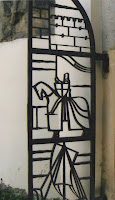I speak mainly of Europe, since I've rarely been anywhere else. (That's why my travels are inconstant!) But there is nothing so mysterious and beguiling as an Old World door you stumble across by sheer chance, on your way to someplace else.
Like this wonderful little Hobbit-like door tucked under a stone archway in the walled medieval town of Noyers-sur-Serein, in the Burgundy district of France. Art Boy and I fell in love with this door! Where does it lead? Who used it? What was its story?
That's the thing about the Old World; it's so much older than the New World! History is right there in front of you at every turn, begging to be discovered, and plumbed. If only we could find the password to get in.
Not all doors are small and atmospheric.
Some are inexplicably massive. I loved the gigantic carving (a man, a mermaid, and some sort of heraldic shield, is my best guess) above what is apparently a residential door in downtown Stockholm, Sweden.
The heavy wooden door is pretty cool too, once I get out of the way so you can see it; look at the size of that doorknob!
Another massive architectural carving decorates this arched double doorway in Leopoldstadt, Vienna, about a block away from the bridge over the Danube Canal into the Inner Stadt (downtown).
Judging from the little plaques, I think this building now houses offices—however grand a past it might have once had.
Here's another wildly carved doorway (although in a very different mood) from the Inner Stadt in Vienna. My guess is this dates from the highly decorative 1910s or 1920s (although it could be much later).
The figures look mythic, and from the star patterns that decorate them, I think they must represent constellations—Perseus, with the snake-haired Medusa head, on the upper left, and Andromeda, in chains, on the right.
The doors inside the alcove are impressive too; I love the contrast between the warm, brandy-colored wood and the cool grey concrete.
The buzzer placket suggests apartments or offices inside, but, sadly, unlike museums, doors you find on the street don't come with labels, so what the use or intent of this portal originally was is lost to the murky depths of Time.
Here we have another very arty door from wonderfully arty Prague.
This is half of a wrought iron gate that leads from a bustling little commercial street in Mala Strana (Little Town) into a quiet courtyard dotted with a couple of shops.
This castle-knight-ship design looks very modernist to me—possibly post-Communism—and as whimsical and charming as all of Prague.
These ornate carved wooden double doors are attached to a small house that has stood empty for years in Mala Strana; we passed them every day when we were in Prague last summer.
Our traveling companion, Donna Mekis, poses here with Art Boy, as we all fantasize about moving in!

Sometimes it's not the door itself, but the decorations that get me.
Look at these wonderful medieval-ish carving on a private door we passed in Prague one day in the vicinity of Nerudova Street!
They don't appear to be door knockers, but simply whimsical carvings for the sheer joy of it. The figures are not exact mirror images of each other, either, so your guess is as good as mine as to why one is upside down.
I thought they might be jesters with very stylized ass' ears, since the jester/fool is the official emblem of Prague (for a people who were as occupied and oppressed for so long as the Bohemians, what can you do but laugh?), although it's hard to tell. But the detail is amazing, especially the faces!
And finally, perhaps the most mysterious of all: this rather alarming, riveted iron door stood in an otherwise unremarkable wall of the tiny kitchen in our apartment in Vienna.
It was locked and bolted, of course, although without this pic as a reference point, I'd be tempted to remember it as being swathed with chains and padlocks—that's how forbidding it was!
It might have been a cellar door guarding dark family secrets (except it's on the fifth floor). It might have been built to keep out the Nazis during World War II.
But—like all the other mysterious doors of Europe—it's like a mystic portal into another world entirely.







Fun doors! And wonderfully silly friends!
ReplyDelete